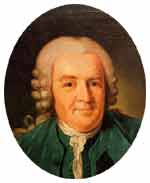 Sweden's great botanist, Carolus Linnaeus (1707-1778), ventured on a journey to Lapland, in the summer of 1732, to conduct studies and collect samples of various plants. He had followed the lead of his teacher, Olof Rudbeck, who had conducted a similar journey, upon royal decree, in 1695. However, most of Rudbeck's records and collections had been destroyed in the great 1702 Uppsala fire. Following several discussions with Rudbeck, Linnaeus reports of "an incredible longing to the mountains in Lapland", and, encouraged by his mentor, he applied to the Vitenskapsselskapet (society of scientific research), in Uppsala, to help fund a new Lapland expedition. Funding was granted, even though the 400 Swedish riksdaler he was awarded was much too little to complete his journey. He had to borrow additional money twice before returning to Uppsala.
Sweden's great botanist, Carolus Linnaeus (1707-1778), ventured on a journey to Lapland, in the summer of 1732, to conduct studies and collect samples of various plants. He had followed the lead of his teacher, Olof Rudbeck, who had conducted a similar journey, upon royal decree, in 1695. However, most of Rudbeck's records and collections had been destroyed in the great 1702 Uppsala fire. Following several discussions with Rudbeck, Linnaeus reports of "an incredible longing to the mountains in Lapland", and, encouraged by his mentor, he applied to the Vitenskapsselskapet (society of scientific research), in Uppsala, to help fund a new Lapland expedition. Funding was granted, even though the 400 Swedish riksdaler he was awarded was much too little to complete his journey. He had to borrow additional money twice before returning to Uppsala.
Linnaeus made painstaking records on his travels, and these were first published in an 1811 English translation. The documentation resulting from these travels formed the basis of the most renown among his early works - Flora Lapponica (1737).
Briefly having ventured into Norway, the journey to Lapland was grueling: there were few roads, most of the journey was on horseback and the first attempt to reach the mountains near the Ume River was halted by spring floods.
Personal contact with the Sami people turned out to be of great significance to Linnaeus. Earlier depictions portrayed the Sami as primitive savages with lax morals. Linnaeus regarded the Sami though as innocents who had become victims of civilization's tyranny.
"Oh, blithesome Sami, who, in the far corner of the world, lives and prospers unnoticed but with the greatest content and innocence! You fear neither hunger nor the winds of war upon your villages - these which all too often lay waste to Europe's most prosperous nations and cities. Here under your reindeer-skin, you gently sleep, free of worry, strife and discord, without knowing what envy is… Easily surpassing one-hundred years, in old age, and in excellent health, you live without sorrow…You live in your forests as the birds, whom neither sow nor reap, but whom the Almighty God nonetheless supplies abundantly with sustenance."
Linnaeus's travel narrative contains numerous depictions of the Sami culture and its mode of living. He had planned on writing a book about the Sami, but this never materialized. The conditions for livelihood, diet and health were things that interested him in particular. Eventually, Linnaeus became a professor of medicine (in addition to botany), and there are many observations of health-related affairs in his travel narratives.
Plant life still was of greatest importance: "I sat down to collect and describe plants so that time was completely forgotten. My interpreter had to remind me of the following 50-60 km we had to pass before reaching our next Sami contact - and that we had better hurry in order to eat…", he writes after the first day in the mountains. The plant life of the mountains was more remarkable than he had believed it to be. In the mountains "I was led to another world, and when we ascended the mountains, I knew neither if I was in Africa nor Asia since the soil, situation and plants were entirely unfamiliar." In this alien world, he had collected a large number of plants which, up to that time, were unknown. Linnaeus was in the mountains for a mere couple of weeks but, during this time, he collected the material to be written about in Flora Lapponica - which perhaps was the most noteworthy accomplishment of his early productions.



